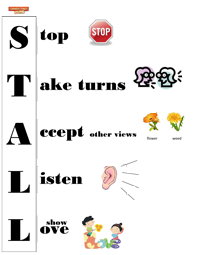Implementing S.T.A.L.L. with Your Kids
In another article we introduced our own conflict resolution plan that can help resolve sibling arguments, conflict and fights. We need to take these types of proactive measures to equip our children to resolve their own conflicts. Here we will talk about the best way to implement S.T.A.L.L. with your kids.
It is best to walk your children through this process at a time of peace using role play. Print out our poster as a reminder of the different elements. Make sure you have multiple copies so every child can have one of their own during the discussion. Remember, your long term goal is to have your children go through this process with minimal involvement from you. Equip, don’t enable.
First, come up with a typical conflictual situation in your home and have the children act it out. Don’t worry if they get silly; you are just teaching the different elements. Have them sit where they are and STOP what they are doing. Explain that, at times, they may need some time apart before they can move on to the next step. This is okay, but they will still need to go through the other elements when tempers have cooled.
Next, talk about the importance of TAKING TURNS. With frustration levels high, interrupting each other is common. Use a stuffed animal or bean bag to pass back and forth to help them remember whose turn it is. Only the person with the stuffed animal can talk. No one can take the stuffed animal from someone else; it can only be given.
Next, they will need to ACCEPT the fact that not everyone will see things things as they do. On the poster, there are two flowers. One is a weed; one is an actual flower. Explain that another person may see the weed as a flower even if they don’t. Differing opinions about the same thing are okay.
LISTENING comes next. This is more than just letting the other person talk; it is actively paying attention so that, if asked, the child could sum up what the other person is trying to say. Have your children practice this by telling each other simple stories from their day.
Finally, your children will need to demonstrate LOVE. The reality is that the conflict may not be completely resolved to the satisfaction of either party. This is not your only goal. Your children can learn that even if they disagree, love trumps all. Have your children talk about ways that they could show love to each other following a conflict.
Tell your kids that if they are struggling to manage a disagreement, you will remind them to use S.T.A.L.L. This reminder can simply be walking to where they are and handing each of them a poster. You will likely need to sit with them the first few times to help them see it in action. Make sure that they are referring to the poster for direction and not you. Your goal is to make yourself obsolete in this process.




Hi, Laura! What a well written article! Thanks for sharing such a unique and effective strategy in managing conflict among children. I am a teacher assistant and am wondering if S.T.A.L.L can translate to the school setting with modifications when needed. Thank you!
Hi Jackie,
I think this would work well in a school setting with some modifications. I am not sure what age group you are working with but early elementary and up is recommended. This method will have an initial upfront “cost” -meaning you have to teach it before you use it. The teachers you work with should all be in agreement to use it for it to be most effective. You would also have to talk about what conflicts you would like to use this for most. If you implemented it for every conflict, it might lose its effectiveness and could bog your day down quite a bit 🙂 Depending on the culture of your classroom you may or may not want to use the word “love” as the final element. That is probably more appropriate for a family context. Let me know if you have any other questions.
Take care,
Laura